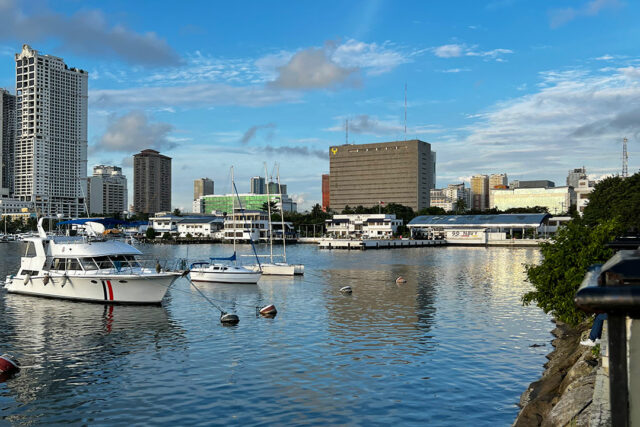Concert Review
Elephant Gym Live in Manila
Dec. 16
Balcony Music House
By Brontë H. Lacsamana, Reporter
FOR Elephant Gym guitarist Tell Chang, it was essential to have Manila as one of the first stops in the band’s world tour this year.
Back in 2018, Filipino fans warmly welcomed the Taiwanese indie rock trio, who headlined the All of The Noise mini music festival. Though it took them five years to arrange a return, the wait was well worth it.
Elephant Gym had a sold-out one-night-only performance at the Balcony Music House in Poblacion, Makati, on Dec. 16.
“The reason we put Manila as our third stop (out of 40 stops) of our tour is because we know the audience here goes crazy,” Mr. Chang said at the show.
While the occasional shouts of “I love your music!” and screams of “Marry me!” often took them aback, Mr. Chang, the bassist (his sister) KT Chang, and the drummer Chia-Chin Tu drew energy from the craziness of Filipino fans to give a remarkable performance.
MAKING AN IMPRESSION
The concert started with the audience singing “Happy Birthday” to Mr. Chang, whose birthday coincided with the show. Shortly after, the band launched into the first four songs of the night — “Frog,” “Games,” “Underwater,” and “Half” — all very intense and instrumentally complicated pieces.
“The four songs we just played are heavy because we want you guys to have an impression that we are strong,” Ms. Chang said after the fourth song.
While she said this in a soft-spoken, sweet manner, it’s worth noting that Ms. Chang’s agile bass playing was the most badass thing this writer saw in any music gig this year.
For those unfamiliar with Elephant Gym, their genre is math rock, which deserves its own explanation.
Math rock is a style of indie or experimental rock that emerged in the United States in the 1980s with bands like Slint, Chavez, and Don Caballero. As its name suggests, it seems mathematical, as it features complex and unusual time signatures.
Many who listen to it might think it sounds odd, but it can be engaging and impressive and kind of like a massage for the ears and mind. (This writer listens to math rock while working since it calms the brain in a stimulating way while not grabbing so much attention as to be distracting.)
As a math rock outfit, Elephant Gym is able to interlace threads of jazz, electronic, and classical music into a unique patchwork of contemporary rock.
The word “elephant” in the band name symbolizes their bass-driven melodies while “gym” refers to nimble, irregular rhythms, a staple of math rock music.
MAKING MUSIC
The fifth song of the night was “Midway,” a fan favorite as it features expressive vocals from Ms. Chang that complement the fast-paced guitar, bass, and drums.
“As musicians, we are always on the midway because we always worry about people not getting into our music,” Ms. Chang said to introduce the song.
She then admitted that making music could be very difficult for artists nowadays who can be overly conscious of what others think.
“But when we got here, we saw so many nerdy guys like you in this venue, so we think that is the reason we make music, because we know you will like it!” Ms. Chang concluded, drawing laughs and cheers from the audience.
Elephant Gym was launched in 2012 in Kaohsiung, Taiwan, with no assurance that any Taiwanese, let alone people from other countries, would take to more of the already-niche sound of math rock.
Little did they know that in 2023, they would have a sizeable following in the Philippines.
COMPLEX EMOTIONS
After the beautiful melodies of “Midway” came the equally exhilarating “Spring Rain” and then the more challenging tune of “Quilt.”
Mr. Chang took over the microphone from his sister at this point and introduced the next song, “D.”
“Commercial and pop culture always talk about the joyful and bright side of life, but musicians or artists like us tend to dig into the negative emotions such as anger, anxiety, depression, and fear, a lot,” he said.
From this familiarity with the negative comes an acceptance of everything and a chance to find peace, he explained — a mindset evident in Elephant Gym’s music, in all its musical twists and turns and complexities.
“D,” followed by “Shadow,” “Head,” and “Body,” all of which flowed together as if in one, long track, featured Ms. Chang on the keyboard. As expected, her keyboard playing was as spirited as her bass playing.
The next song was “Go Through the Night,” their popular tribute to Japanese math rock band Toe, one of the flagbearers of the genre from the early 2000s up to today.
“The acoustic guitar part is sampled from Toe. They’re our hero, and our first album Balance is mixed by their guitar player,” said Mr. Chang. Much of the crowd sang along to the memorable opening notes of the acoustic guitar and moved their bodies with enthusiasm as the band built on the sample.
MORE VARIETY
Elephant Gym closed out their live show in Manila with an eclectic mix of their songs, both relatively new and old.
The jazzy yet dissonant “Witches” kept heads bobbing. Meanwhile, the immensely popular “Finger” started off with a soft, catchy tune that the crowd sang along to, until the guitar riffs intensified and the drums sped up, causing people to headbang more fiercely.
As the song “Moonset” began playing, an audience member excitedly yelled out the title, a hilarious contrast to the mellow, jazzy rhythm that followed.
Then came the last two songs, “Ocean in the Night” and “Galaxy,” from their first album. The twinkly, complicated instrumentals along with the siblings’ vocal blending made for a wonderful conclusion to an energetic night, a showcase of Ms. Chang, Mr. Chang, and Mr. Tu’s technique and stage presence.
“We’re very thankful that you guys came here to experience all the emotions in our music,” Mr. Chang told the crowd.
While math rock is not that popular a genre (with local acts like Tom’s Story and tide/edit having a small niche among Filipino indie music lovers), it’s safe to say that Elephant Gym managed to carve out their own space within it.
As their name suggests, they provided compelling music driven by powerful bass lines and their love to play around as they please — and they successfully brought it to Manila for one night.

















